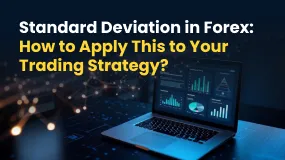简体中文
繁體中文
English
Pусский
日本語
ภาษาไทย
Tiếng Việt
Bahasa Indonesia
Español
हिन्दी
Filippiiniläinen
Français
Deutsch
Português
Türkçe
한국어
العربية
How to stop yourself from over trading
Abstract:Overtrading is a common problem among investors and traders. It occurs when an individual trades excessively, often to the point where it negatively impacts their overall profitability.

Overtrading is a common problem among investors and traders. It occurs when an individual trades excessively, often to the point where it negatively impacts their overall profitability. Overtrading can be caused by several factors, including emotional decisions, impulse trading, and a lack of discipline. Fortunately, there are several steps that you can take in order to reduce your tendency to overtrade.
1. Have a trading plan
Having a trading plan is one of the most important things that you can do to reduce overtrading. Your trading plan should include your risk tolerance, profit goals, and the specific securities or assets that you intend to trade. Having a plan will help you to stay focused and reduce the likelihood of making impulsive decisions.
2. Set specific trading goals
Setting clear trading goals can also help you to reduce overtrading. Its important to have specific goals for each trade, such as a profit target or a stop-loss limit. This will help you to stay on track and avoid making trades that are not in line with your overall trading strategy.
3. Avoid emotional decisions
Emotional decisions are a major cause of overtrading. Its important to remain calm and rational when making trading decisions. Avoid trading based on emotions such as fear or greed. Instead, focus on analyzing the data and making rational decisions based on your trading plan.
4. Use technical analysis
Technical analysis is a powerful tool that can help you to make better trading decisions. It involves analyzing charts and other data to identify trends and patterns. This can help you to make more informed decisions about when to buy or sell a particular security.
5. Use stop-loss orders
Using stop-loss orders can help you to reduce your risk when trading. A stop-loss order is an order to sell a security when it reaches a certain price point. This can help you to limit your losses and avoid overtrading.
6. Take breaks
Taking breaks from trading can also help you to reduce overtrading. Its important to take breaks throughout the day to clear your mind and reduce stress. This will help you to make better decisions and avoid impulse trading.
7. Seek professional help
If you find that you are still struggling with overtrading, it may be helpful to seek professional help. A financial advisor or trading coach can help you to identify the underlying causes of your overtrading and develop a personalized plan to overcome it.
In conclusion, there are several steps that you can take to reduce overtrading. By having a trading plan, setting specific goals, avoiding emotional decisions, using technical analysis, using stop-loss orders, taking breaks, and seeking professional help, you can improve your trading performance and reduce the negative impact of overtrading. Remember, successful trading requires a combination of knowledge, discipline, and self-control. So, always trade with caution and make informed decisions.

Disclaimer:
The views in this article only represent the author's personal views, and do not constitute investment advice on this platform. This platform does not guarantee the accuracy, completeness and timeliness of the information in the article, and will not be liable for any loss caused by the use of or reliance on the information in the article.
Read more

A Guide to Determining the Optimum Forex Leverage
Want to gain a wider forex market position control by investing a minimal amount? Consider using leverage in forex. It implies using borrowed funds to raise your trading position more than your cash balance can let you do it. Forex traders usually employ leverage to churn out profits from relatively small currency pair price changes. However, there is a double-edged sword with leverage since it can multiply profits as well as losses. Therefore, using leverage in the right amount is key for traders. Forex market leverage can be 50:1 to 100:1 or more, which remains significantly greater than the 2: leverage usually offered in equities and 15:1 leverage in futures.

Slippage in Forex Explained: Key Facts to Improve Your Trading Strategy
Have you witnessed a difference between the expected price of a trade and the price at which it is executed in real time? This might be due to slippage, which can happen at any time. However, it prevails mostly when the market remains highly volatile. At the same time, it can also happen during large order executions. Read on to know more about slippage, its impacts, and the strategies to rein in adverse effects.

Forex Trading Account Types and Their Features: Read This Insightful Guide
Want to open a forex account to enjoy the thrill of compounding returns? You should first know the various forex trading account types. Choosing the right option from the list of forex accounts is critical to experiencing a hassle-free and successful trading journey. Forex brokers design trading accounts based on your needs, trading experience, and financial goals. Therefore, understanding each forex trading account type and its key features becomes essential.. This will help you make the right choice. In this article, we have discussed everything about forex accounts. Take a look!

Standard Deviation in Forex: How to Apply This to Your Trading Strategy?
Do you recall the concept of standard deviation being taught in your school days? The concept, which measures the variation within a set of data points relative to the mean average of the dataset. A greater standard deviation hints at higher variability. On the other hand, a lower standard deviation means lower variability from the mean. But what is standard deviation in forex, and how can you apply it to your trading strategy? This is what we will discuss here.
WikiFX Broker
Latest News
Stonefort Broker Review 2025: Legit or Risky? A Complete Analysis
CHINA BEST Broker Review: Regulation and Risks
Uniglobe Markets Review 2025: A Safe Broker or a High-Risk Scam?
Chicago Fed's Goolsbee says he's cautious about further rate cuts during shutdown
These Are Europe's Top Economies By Projected 2026 GDP
Quantower Review 2025: User Reviews and Complaints in India
TD Markets Exposed: Price Manipulation, Withdrawal Issues & False Promises Hurt Traders
Bank of England holds rates steady in narrow vote ahead of Autumn Budget
BingX Review: Traders Angry Over Withdrawal Denials, Account Blocks & More
Stonefort Securities Review: A Fair Look at Safety, Rules, and What Traders Say
Currency Calculator




